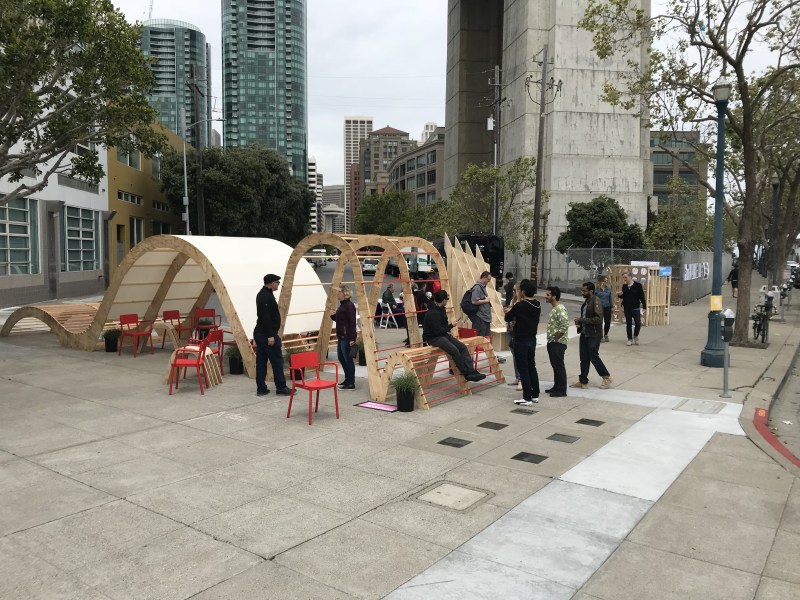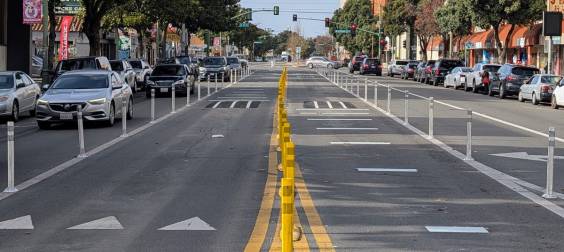Note: GJEL Accident Attorneys regularly sponsors coverage on Streetsblog San Francisco and Streetsblog California. Unless noted in the story, GJEL Accident Attorneys is not consulted for the content or editorial direction of the sponsored content.
This past weekend marked the fourth 'Sunday Streets' event of the year--this time in the Tenderloin. But there was another, lesser-known neighborhood-building street event this weekend in San Francisco: Saturday's Spear Street Pop-Up Party. It took place at the cul-de-sac where Spear dead-ends just before the Embarcadero.
The pop-up was part of a larger project to revitalize the area.
"The idea is that the Planning Department, in partnership with The East Cut Community Benefit District (CBD), would sponsor a studio to explore turning the site into a park," wrote Anne Brask, Planner/Urban Designer with the San Francisco Planning Department, in an email to Streetsblog. California College of the Arts students built prototype art pieces they'd like displayed permanently if it becomes a park. If people like the art and the pop-up party "The city can then go and seek funding to make more permanent improvements to the space," explained Brask.

The event and the move to turn the end of Spear into a park is part of the larger South Downtown Design and Activation Plan (SODA) which, according to its web page, "will provide a framework for designing, implementing and managing the public realm in the emergent neighborhood surrounding the Transbay Terminal and Rincon Hill. The plan area covers a quadrant of roughly 30 blocks of the city bounded by Market Street, The Embarcadero, Bryant Street and 2nd Street."
As Paul Chasan of the San Francisco Planning Department, explained during a presentation about the SODA project last year, 15 years ago the area had little vibrancy and was full of parking craters. With this current plan, the city hopes to “… enhance the built environment,” he explained. And to “… elevate the experience [of the neighborhood] and prioritize safety and mobility.”
One would think since the city is involved in the overall SODA project, other city bureaucrats would be happy to let the CBD do its pop-up event. But when they brought it to the city's Interdepartmental Staff Committee on Traffic and Transportation (ISCOTT), which regulates such things, they were told it would cost around $900 to close off the cul-de-sac.

Andrew Robinson from the CBD thought it would be simple to get the fee waived, considering there would be no impact on traffic whatsoever. They weren't serving food (so no need for a health department permit) and he said the entertainment commission waived the fee for playing music. He thought "It was a slam dunk" to hold the pop-up at the end of Spear, he told Streetsblog during a phone interview. But "we still couldn’t find a way that was reasonable and streamlined " The ISCOTT committee wouldn't waive the fee so they decided just to keep it on the sidewalk.
Although, as seen below, some people decided to set up a table just off the curb anyway. Is this photographic evidence that the CBD broke the law by using a street for people, instead of cars, without paying the $900 permit? “I might frame it differently, but the answer is 'yes,'” said Robinson.

The question though is who is breaking the law exactly--the CBD or the ISCOTT committee? Readers might be wondering whatever happened to the "Places for People" ordinance, passed unanimously last year by the San Francisco Board of Supervisors. It directed city agencies to reduce fees and streamline the process for applying for a permit for using the street for something other than vehicle travel and parking. "The city hasn’t been able to yet do it," said Robinson.
"ISCOTT application fees are not waived, because they are required to be revenue neutral and the fees are designed to cover the costs of the program," wrote Paul Rose, an SFMTA spokesman, in an email to Streetsblog.

Either way, the event seems to have been a success. Robinson said "even when they were building their prototypes at 7 in the morning, people walking by were like 'oh my god, it’s a different space.'” He also hopes eventually the city will build a sidewalk cut-through so cyclists can turn off the bike lane on Embarcadero onto Spear directly, as a way to start turning the cul-de-sac into a most inviting and accessible space.
"The one-day 'pop-up' was a critical step to get everyone (city staff and the community) excited about the idea and let folks imagine what was possible at the site. Having students prototype designs with the help of local designers (Perkins + Will, Gensler, Niantic, and Google) was a great way to start the process... The students deserve a lot of props for their installations, they really warmed up the cul-de-sac area and engaged many passers-by and residents," wrote Brask. Apparently, the event was well attended--the count was about 150 people, said Robinson.
That's all great, but something is wrong when city officials can't allow for the fact that Spear is a cul-de-sac and closing it for a few hours on a Saturday doesn't even require traffic control, city services, or really anything except bureaucratic flexibility.
Want to participate in long-term improvements for Spear's cul-de-sac, vote for your favorite treatment/artwork here.






